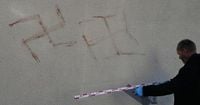Residents of Hanau, Germany, awoke to a chilling scene on the morning of November 6, 2025: nearly 50 cars, along with several mailboxes and building facades in the city’s Lamboy district, had been defaced with swastikas painted in human blood. The disturbing act quickly drew national attention, not only for its grisly nature but also for the deeply painful history it invoked in a city still scarred by a far-right terrorist attack just five years prior.
According to AP and BBC, the first alert came late on November 5, when a resident noticed a swastika—drawn in what appeared to be a reddish liquid—on the hood of a parked car. Police responded, and a special test soon confirmed the substance was indeed human blood. As officers canvassed the area, they discovered that the vandalism extended far beyond a single vehicle. In total, almost 50 cars, as well as some mailboxes and building facades, bore the same sinister mark. Other, less identifiable scribblings were also found on several surfaces.
Police spokesman Thomas Leipold told reporters, “The background is completely unclear.” He explained that investigators did not initially know whether the vandalism was targeted or random, nor did they have any information about who was responsible or where the blood had come from. Importantly, authorities said there were no reports of injuries related to the incidents, a fact that provided some relief amid the shock.
The use and public display of Nazi emblems, including the swastika, is strictly illegal in Germany, a law rooted in the country’s efforts to confront its past and prevent the resurgence of extremist ideologies. As The Guardian noted, the swastika remains a potent symbol of hate, evoking the trauma of the Holocaust and the horrors of Nazi Germany. Despite these prohibitions, white supremacists, neo-Nazi groups, and vandals have continued to use the symbol to stoke fear and division long after the end of World War II.
Hanau, a city near Frankfurt, is no stranger to such pain. On February 19, 2020, a far-right extremist killed nine people with immigrant roots in a rampage at a local hookah bar, one of the deadliest acts of domestic terrorism in Germany since the war. The gunman later died by suicide, but the wounds he inflicted on Hanau’s diverse community have never fully healed.
Mayor Claus Kaminsky, visibly shaken, addressed the public on the morning of November 6. “Especially in our city, which was deeply affected by the racist attack on February 19, 2020, such an act causes deep consternation,” he said, as reported by AP and German news agency dpa. The city promptly filed a criminal complaint. Kaminsky added, “What happened here crosses every boundary of decency and humanity. Swastikas have no place in Hanau. We will not allow such symbols to sow fear or division.”
As the investigation unfolded, police received a crucial tip-off. By Thursday afternoon, authorities had detained a 31-year-old Romanian man at his home in Hanau. In line with German privacy rules, his name was not released. According to BBC and AP, a breathalyser test conducted at the time of arrest revealed the suspect had a high blood alcohol level. Officers also noted that he had injuries that appeared to be self-inflicted.
Police spokesman Leipold provided further insight into the suspect’s state of mind: “He was still under the strong influence of alcohol and his motive appears to be highly personal and job-related – he just snapped.” Initial findings suggested that the man’s actions were a reaction to an incident at work, and officials indicated he would be referred to a psychiatric clinic for further evaluation.
The rapid identification and arrest of the suspect brought some reassurance to the city, but the event nonetheless reopened old wounds. Bundestag Vice President Omid Nouripour expressed his own shock, writing on X, “This act strikes at the very heart of Hanau and reopens the wounds of the far-right terrorist attack five years ago.”
For many in Hanau and across Germany, the incident was a stark reminder of the persistent dangers posed by hate-fueled ideologies and the need for vigilance. As The Independent observed, Germany’s political landscape has grown increasingly polarized in recent years, with a wave of immigration and a slowing economy fueling support for extremist groups at both ends of the political spectrum. This broader context has heightened sensitivities around acts of hate and the symbols associated with them.
Authorities emphasized that, despite the deeply disturbing nature of the crime, there was no evidence to suggest a broader conspiracy or the involvement of additional suspects. For now, police are investigating the case as one of property damage and the use of symbols of unconstitutional organizations, a charge that carries serious legal consequences in Germany.
The events in Hanau also prompted a renewed conversation about the city’s resilience and commitment to unity. Mayor Kaminsky’s words resonated with many: “We will not allow such symbols to sow fear or division.” Community leaders and residents echoed this sentiment, determined to ensure that the city’s response to hate is one of solidarity and resolve.
While the suspect’s personal motives remain under scrutiny, the broader impact of his actions is clear. The use of human blood to paint swastikas was a grotesque provocation, intended—or at least interpreted—to instill fear and outrage. Yet, as history has shown, Hanau’s community has faced down hate before and emerged with its values intact.
The investigation is ongoing, and authorities continue to piece together the full sequence of events and the suspect’s state of mind. For now, the city’s focus is on healing and reaffirming its commitment to tolerance, remembrance, and the rule of law.
The scars of the past are never far from the surface in Hanau, but neither is the city’s determination to move forward. In the words of one local official, “What happened here will not define us. How we respond—together—will.”


